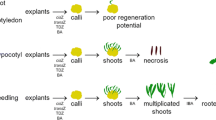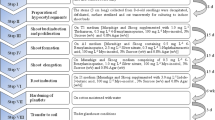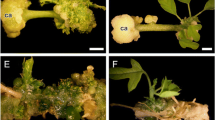Abstract
The relative importance of explant, cytokinin type, carbon source and gelling agent for annatto organogenesis was studied. The best organogenic response, including adventitious shoot number and elongation, was obtained when hypocotyl segments and rooted hypocotyls were cultured onto MS medium supplemented with 4.56 μM zeatin, 87.6 mM sucrose, and 2.8 g l−1 Phytagel®. Adventitious shoots derived from hypocotyl segments were less frequent and more difficult to elongate than those derived from rooted hypocotyls. Thidiazuron (TDZ) promoted a higher organogenic response in rooted hypocotyls, resembling a rosette-like structure, but impaired shoot elongation. Histological investigation showed that zeatin-induced meristemoids originated mainly from wounding tissues, and that TDZ induced a high level of mitotic division resulting in several proliferation zones nearby the epidermis and outer cortical tissues. Rhizogenesis efficiency (rooting frequency and root number) was greater at the highest indole-3-butyric acid (IBA) concentration (5.0 μM) employed, although calli occurred at the basal end of shoots. Eighty percent of rooted plantlets survived after acclimatization. This optimized regeneration protocol may enable further development of an efficient genetic transformation protocol for this species.
Similar content being viewed by others
References
Al-Jaboory KH, Skirvin RM & Williams DJ (1998) Callus induc-tion and adventitious shoot regeneration of gardenia (Gardenia jasminoides Ellis). Sci. Hort. 72: 171–178
Biahoua A & Bonneau L (1999) Control of in vitro somatic embryogenesis of the spindle tree (Euonymus europaeus L.) by the sugar type and the osmotic potential of the culture medium. Plant Cell Rep. 19: 185–190
Borkowska B & Szezebra J (1991) Influence of different carbon sources on invertase-activity and growth of sour cherry (Prunus cerasus L.) shoot cultures. J. Exp. Bot. 42: 911–915
Buter B, Pescitelli SM, Berger K, Schmid JE & Stamp P (1993) Autoclaved and filter sterilized liquid media in maize anther culture: significance of activated charcoal. Plant Cell Rep. 13: 79–82
D'souza MC & Sharon M (2001) In vitro clonal propagation of annatto (Bixa orellana L.). In Vitro Cell. Dev. Biol. - Plant 37: 168–172
Eapen S, Tivarekar S & George L (1998) Thidiazuron-induced shoot regeneration in pigeonpea (Cajanus cajan L.). Plant Cell Tiss. Org. Cult. 53: 217–220
Fuentes SRL, Calheiros MBP, Manetti-Filho J & Vieira LGE (2000) The effects of silver nitrate and different carbohydrate sources on somatic embryogenesis in Coffea canephora. Plant Cell Tiss. Org. Cult. 60: 5–13
Gamborg OL, Miller RA & Ojima K (1968) Nutrient requeriments of suspension cultures of soybean root cells. Exp. Cell Res. 50: 151–158
García-Luis A, Bórdon Y, Moreira-Dias JM, Molina RV & Guardiola JL (1999) Explant orientation and polarity determine the morphogenic response of epicotyl segments of Troyer citrange. Ann. Bot. 84: 715–723
Henry BS (1996) Natural food colours. In: Hendry GAF & Houg-hton JD (eds) Natural Food Colorants (pp. 0–79). Blackie Academic Professional, Glasgow
Huang LC, Kohashi C, Vangundy R & Murashige T (1995) Effects of common components of hardness of culture media prepared with gelrite. In Vitro Cell. Dev. Biol. - Plant 31: 84–89
Huetteman CA & Preece JE (1993) Thidiazuron: a potent cytokinin for woody plant tissue culture. Plant Cell Tiss. Org. Cult. 33: 105–119
Johansen DA (1940) Plant Microtechnique. McGraw-Hill, New York
Kärkönen A (2000) Anatomical study of zygotic and somatic embryos of Tilia cordata. Plant Cell Tiss. Org. Cult. 61: 205–214
Klimaszewska K, Bernier-Cardou M, Cyr DR & Sutton BCS (2000) Influence of gelling agents on medium gel strength, water availability, tissue water potential, and maturation response in embryogenic cultures of Pinus strobus L. In Vitro Cell. Dev. Biol. - Plant 36: 279–286
Kotsias D & Roussos PA (2001) An investigation on the effect of different plant growth regulating compounds in in vitro shoot tip and node culture of lemon seedlings. Sci. Hort. 89: 115–128
Ladyman JAR & Girard B (1992) Cucumber somatic embryo development on various gelling agents and carbohydrate sources. Hort. Sci. 27: 164–165
Leonardi C, Ruggeri A & Malfa S (2001) Hormone effects on in vitro proliferation and rooting of Grevillea explants. Sci. Hort. 90: 335–341
Marks TM & Simpson SE (2000) Interaction of explant type and indole-3-butyric acid during rooting in vitro in a range of difficult and easy-to-root woody plants. Plant Cell Tiss. Org. Cult. 62: 65–74
Mensuali-Sodi A, Panizza M & Tognoni F (1992) Quantification of ethylene losses in different container-seal systems and com-parison of biotic and abiotic contributions to ethylene accumula-tion in cultured tissues. Physiol. Plant. 84: 472–476
Muday GK & DeLong A (2001) Polar auxin transport: controlling where and how much. Trends Plant Sci. 6: 535–542
Murashige T & Skoog F (1962) A revised medium for rapid growth and bioassays with tobacco tissue cultures. Physiol. Plant. 18: 473–497
Murthy BNS & Saxena PK (1998) Somatic embryogenesis and plant regeneration of Neem (Azadirachta indica A. Juss). Plant Cell Rep. 17: 469–475
Neštákova M, Havrlentová M & Faragó J (2000) Effect of gelling agents on in vitro multiplication of two ornamental plants. Biologia, Bratislava 55: 409–411
Pérez-Molphe-Balch E & Ochoa-Alejo N (1997) In vitro plant regeneration of Mexican lime and mandarin by direct or-ganogenesis. Hort. Sci. 32: 931–934
Pérez-Tornero O, Egea J, Olmos E & Burgos L (2001) Control of hyperhydricity in micropropagated apricot cultivars. In Vitro Cell. Dev. Biol. - Plant 37: 250–254
Petersen KK, Hansen J & Krogstrup P (1999) Significance of different carbon sources and sterilization methods on callus induction and plant regeneration of Miscanthus×ogiformis Honda 'Giganteus'. Plant Cell Tiss. Org. Cult. 58: 189–197
Pritchard J, Wyn-Jones RG & Tomos AD (1991) Turgor, growth and rheological gradients in wheat roots following osmotic stress. J. Exp. Bot. 42: 1043–1049
Pua EC (1999) Morphogenesis in cell and tissue cultures role of ethylene and polyamines. In: Soh W-Y & Bhojwani SS (eds) Morphogenesis in Plant Tissue Cultures (pp. 255–303). Kluwer Academic Publishers, Dordrecht
Scherer RA, Muller E, Lippert H & Wolff G (1988) Multielement analysis of agar and gelrite impurities investigated by inductively coupled plasma emission spectrometry as well as physical properties of tissue culture media prepared with agar and gellan gum gelrite. Acta Hort. 226: 655–658
Scholten HJ & Pierik RLM (1998) Agar as a gelling agent: differential biological effects in vitro. Sci. Hort. 77: 109–116
Sharma P & Rajam MV (1995) Genotype, explant and position effects on organogenesis and somatic embryogenesis in eggplant (Solanum melongena L.). J. Exp. Bot. 46: 135–141
Sul I & Korban SS (1998) Effects of media, carbon sources and cytokinins on shoot organogenesis in the Christmas tree Scots pine (Pinus sylvestris L.). J. Hort. Sci. Biotech. 73: 822–827
Tonon G, Capuano M & Di Marco A (2001) Plant regeneration of Fraxinus angustifolia by in vitro shoot organogenesis. Sci. Hort. 87: 291–301
Tsuro M, Koda M & Inoue M (1999) Comparative effect of different types of cytokinin for shoot formation and plant regeneration in leaf-derived callus of lavender (Lavandula vera DC). Sci. Hort. 81: 331–336
Valera-Montero LL & Ochoa-Alejo N (1992) A novel approach for chili pepper (Capsicum annuum L.) plant regeneration: shoot induction in rooted hypocotyls. Plant Sci. 84: 215–219
Vieira IMS, Barbosa ASA, Serra AGP, Silva SPG, Mota MGC & Botelho MN (2000) Embriogênese somática de urucu (Bixa o orellana), cultivar EMBRAPA-37. Proceedings of 51° Congresso Brasileiro de Botânica. Brasília (p. 23)
Author information
Authors and Affiliations
Corresponding author
Rights and permissions
About this article
Cite this article
Borges de Paiva Neto, V., Ribeiro da Mota, T. & Campos Otoni, W. Direct organogenesis from hypocotyl-derived explants of annatto (Bixa orellana). Plant Cell, Tissue and Organ Culture 75, 159–167 (2003). https://doi.org/10.1023/A:1025063906822
Issue Date:
DOI: https://doi.org/10.1023/A:1025063906822




